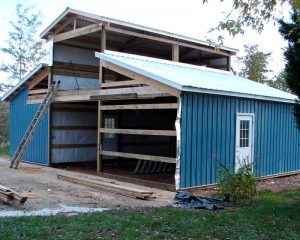In researching the paint systems applied to steel roofing and siding used on pole buildings, I came up with some interesting information.
From an August 2003 story in Metal Roofing Magazine:
“There are dozens of criteria and tests paints are subject to, including falling sand erosion tests, acid tests, adhesion after impact and bending, and salt spray and acid rain simulations. One of the more important characteristics is hardness, or scratch resistance, which is measured in pencil hardness. The test (ASTM D3363) uses pencil leads, ranging from 9H (hardest) to 6B (softest), to determine the hardest that will not scratch the coating. One pencil is the difference between two adjacent lead types.”
OK, I can readily see where this would be fairly important information to know, especially for those who are doing installations – whether a professional builder, or a D-I-Yer.
 The pencil hardness test is very simple to do, gives uniform results, and is dependable because the pencils are graded. The grade of the pencil is determined by the amount of baked graphite and clay in its composition.
The pencil hardness test is very simple to do, gives uniform results, and is dependable because the pencils are graded. The grade of the pencil is determined by the amount of baked graphite and clay in its composition.
I remember graded pencils from my junior and senior high school mechanical drawing classes. I was fortunate to have instructors who would let me draft at my own pace – they would give me all of the assignments for an entire semester at the beginning of the class, and I’d have them all done in a matter of a few weeks. I enjoyed drafting so much, I’d go to school early and skip lunches to be drawing.
Well, those graded pencils come in an assortment of both hard and soft, and can be found in most art or office supply stores. Pencil grades are designated such as H (hardness), B (blackness) and HB (hard and black). The hardest lead would be 9H, followed by 8H, 7H, etc., to H. F is in the middle of the hardness scale; then comes HB, B, 2B….to 9B, which is the softest. The most commonly used writing pencil is a #2, which would be equal to HB grade. It is fairly soft, contains more graphite, and leaves a dark mark.
Here is an audience participation type test which can actually be done at home! It does involve the investment into a variety of differently graded pencils. Once the pencils have been acquired, select one and make a line about ½ inch long on the “outside” of a piece of painted steel. If this pencil scratches the surface of the coating, go to the next softer pencil and repeat the drawn line until the first pencil which doesn’t scratch the coating. Do the test again, and if the same results are obtained, this is the “Pencil Hardness” of the coating.
It is important to understand the degree of hardness of any generic coating may not always be the same. One company’s SMP (Silicone-modified polyester) paint finish will not necessarily be the same hardness as the next.
In my humble opinion, the ability of a painted steel panel to resist scratching is fairly important. What is odd (at least to me) is I have done significant online research, and have only been able to find one company (McElroy Metals) which lists even a single paint system (their Kynar® 500 panels as having a rating of HB to 2H. I’ll keep looking on this one.






